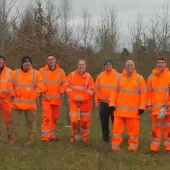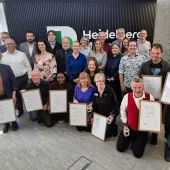Pilot bio-monitoring scheme used at Rugeley Quarry

Insect DNA analysis technique used to reveal natural condition and environmental health of quarry site
FOR the first time in the UK, a nature-monitoring scheme analysing the DNA of insects has been used to evaluate the natural condition and environmental ‘health’ of a site. It is hoped that the project will provide the next generation of solutions to improve habitats for wildlife across CEMEX UK’s 400 operational sites.
The pilot scheme, which was run at CEMEX UK’s Rugeley Quarry, near Cannock, in the West Midlands, revealed two rare species of fly and two scarce species of fly. CEMEX UK are working with the Royal Society for the Protection of Birds (RSPB) to restore lowland heathland habitat at the site.
CEMEX UK and the RSPB have collaborated with the Biodiversity Institute of Ontario (BIO) and SAP (System Applications Products) to collect insects using a Malaise trap and apply DNA barcoding technologies with data analytics to map the species found at the site.
The results have revealed the presence of two nationally rare flies, Eurthyneura albipennis and Platypalpus pulicarius, both of which have only been recorded at three UK sites, plus two nationally scarce species, Meromyza mosquensis and Rhaphium micans.
‘Both this groundbreaking technology and the results are of tremendous importance, and it has been fascinating to find such rare species present at Rugeley,’ said Andy Spencer, director of sustainability at CEMEX UK. ‘The DNA analysis of insects could offer the next generation of solutions to managing and conserving the biodiversity around the company’s 400 operational sites.’
The pilot involved capturing insects on site using a Malaise trap – a mesh tent with an opening for insects to fly in to – and collecting their DNA sequences to be compared to BIO’s database of more than 5.5 million species barcode sequences to give an accurate species map for the collection site.
Sam Tarrant, business conservation manager with the RSPB, said: ‘This new and innovative project is another brilliant example of conservation and business working effectively together to help build a brighter future for nature. Using the insect DNA we are able to establish the natural condition of sites and then work with CEMEX on how best to move forward to turn them into first-class homes for nature.
‘It’s amazing to see these former quarry sites returned to nature and to watch flocks of birds, wild plants and insects slowly take over. And to think that just a few years ago CEMEX were excavating minerals from some of these areas and now they are beautiful nature reserves alive with wildlife for everyone to enjoy.'
Providing first-class natural habitat for wildlife by restoring worked-out areas in quarries has been one of the aims of the partnership between CEMEX UK and the RSPB. This groundbreaking new scheme will help map out the species found at these restored wildlife sites, allowing conservationists to develop the perfect habitats for the UK’s struggling species.









